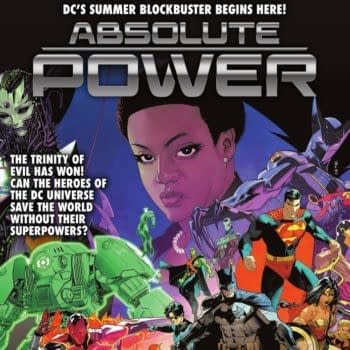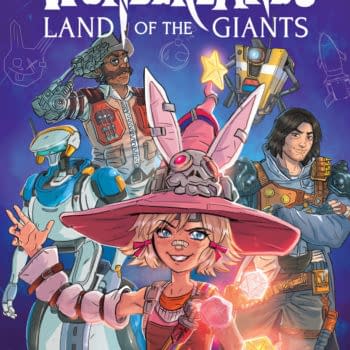Posted in: Do Anything. Thoughts on Comics and Things by Warren Ellis | Tagged:
Do Anything 012 by Warren Ellis
012
The story's well known, now. Disenchanted with Marvel — with the constraints on his creativity, with not getting his original art back, with Stan bloody Lee and his bloody ocarina (and, perhaps, with Stan Lee suddenly emerging as a pop-culture celebrity, embraced as an intellectual on the college lecture circuit while Jack had to crank out an insane number of pages a month) —
(Stan Lee even briefly rebranded the comics in 1965 as "Marvel Pop Art Productions." An attempt to make them more saleable to the students who were discovering comics, probably. Maybe even a gag. But all of a sudden, there was a comics publisher trying to place their comics right in the middle of the cultural conversation, in a time when comics were still sold on news stands. It was too little too late — Roy Lichtenstein had already let off his fireworks and was moving on, Jasper Johns had already produced his major works, Rauschenberg was drifting off, Warhol was already more interested in making movies, Pop Art was on the wane. It only lasted a few months. But you can almost see through a veil, a waxy spot in the air, and glimpse blurred motions in another world.)
(We're drifting away from the history we know, feeling our way through some cool, misty limbo-point between universes — what sf writers call a Jonbar Hinge, the point of divergence between timelines. And what's that appalling bloody noise over the ocarina howl? That wheezing, groaning noise? It's the sound of a set of keys being dragged across the strings of a broken piano and processed by the mad science of the BBC Radiophonic Workshop. This sound, the sound of the TARDIS, accompanies the manifestation of a weird throne whose surface cycles between metal and stone. It is occupied by a man who is mostly hair, armour rings and eyes that look like they can see into your soul and are fairly disappointed with its number of legs. Alan Moore, who earlier intoned the word "Ideaspace" at us before disappearing in a numinous cloud of lightning and dopesmoke, is here to tell you the story of when, as a kid bedridden with some standard disgusting childhood disease, he sent his mother out to buy him a copy of BLACKHAWK and she came back with a copy of FANTASTIC FOUR. It must have been sometime between 1961, when FANTASTIC FOUR was released, and 1963, when DOCTOR WHO commenced. 1963, probably not coincidentally, was also the title of Alan Moore's playful six-issue rumination on those formative Marvel comics of his youth. We are travelling in time. Young Alan Moore was sliding between worlds — the expected polite action-adventure of BLACKHAWK, the sort of pleasant, ordinary entertainment dealt in back then, replaced by the raw, crackling, craggy pages of Jack Kirby and the violent declamations of Stan Lee. Imagine if that humming imaginative payload had come with a Pop Art Productions tag in a time when Pop Art still mattered? Contemporaneous with Lichtenstein utilising comics panels in/as his paintings?)
(It's a two-edged thing. A Jonbar Hinge. Perhaps the infant Moore, whose beard at this point may only have been two feet long, would suddenly understand comics to be modern art — that this issue of FF was sharing a playing field not with Blackhawk, but with Andy Warhol. And perhaps he quite fancies that. The flirtation with underground comics styles that define his earliest period never happens, and he surfs into comics as an adult on the crest of whichever leading wave has followed Pop Art. Or, perhaps, young Alan sees this and suddenly understands, with an awful cold shock, that comics are dead, nothing but compost for hip New York art-stunt purveyors. Looking back from the 21st Century, he might now consider Lichtenstein as nothing but the Damien Hirst of newsprint, sawing pages in half to no revelation whatsoever. Maybe he gives up on comics at that moment, saddened and repelled, and decides right then to devote himself to music.)
(Jack Kirby once said: "Comics will break your heart.")
— Jack decamped to DC Comics in 1970.
ANYTHING
"There's That Goddamn Sun Again"
Another day down the mines of our lives. We drink 'til we stink and smoke 'til we choke because that's how we get things done, you and me. Spending our lives making things and making things out of our lives, because anything else would be dull as hell and we're damned if we're going to sit at the other end of whatever years we get saying, well, what the fuck was that for?
Years of scars, lipstick and tears, and every day the dawn comes on we turn our eyes up in surprise, saying, "There's that goddamn sun again."
© Warren Ellis 2006
COLOPHON
I can be sent things via Avatar Press at Avatar Press, 515 N. Century Blvd., Rantoul, IL 61866, USA, but I cannot promise a response or a review. Although, let's be honest, it's fairly likely, as eventually the ANYTHING section will need to be about comics. You can email me at warrenellis@gmail.com, but I warn you, it's a dump address, not my regular email address, so it can take me a few days to check it.
DO ANYTHING is © Warren Ellis 2009, all rights reserved.












